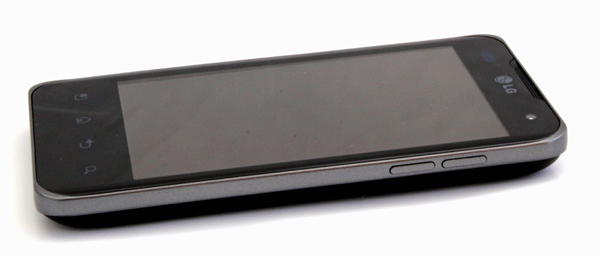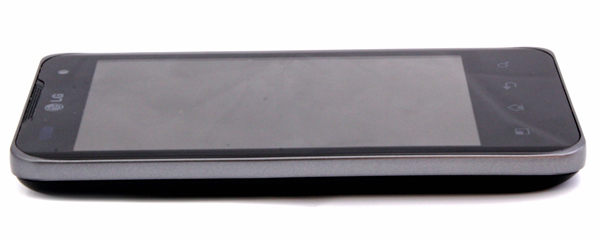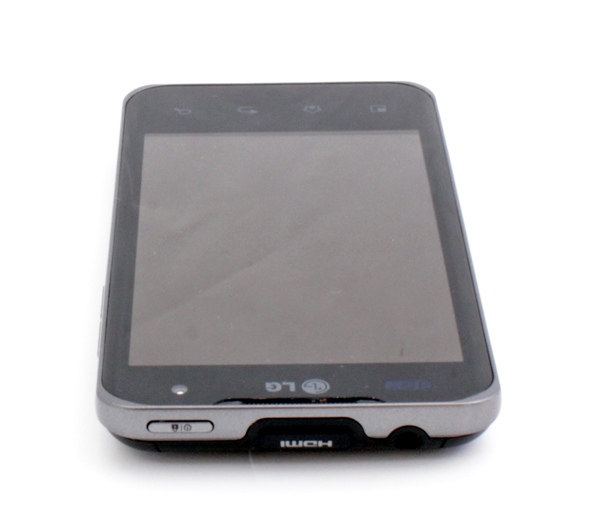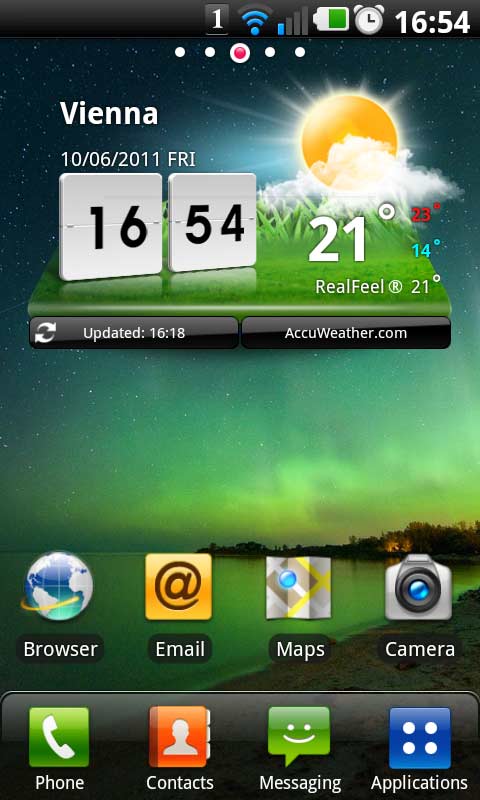We had a chance to talk to many executives from Nvidia including the CEO Jenesen Huang as we had some issues to understand the mobile / tablet turn that a company took some two three years ago. Nvidia was dedicated as the management figured out that smartphones and tablets will become an important part of our lives from 2010 and beyond. They were not wrong about this, only if Google had been a bit faster with Android 3.0 development.
The first phone powered by Tegra 2, and the first dual-core phone ever was the LG’s Optimus 2X that was officially announced on March 1st and available about a month later. The 2X moniker naturally tells you that it has two cores and from our testing experience we can tell you that the battery life remains comparable to a single core high end phone, but the performance is usually better, depending on the application.
Our first impression of LG Optimus 2X is that it looks very similar to the iPhone 3GS with the exception that it's a bit boxier than the 3GS. For the untrained eye, it looks like some sort of an iPhone. The large LG logo on the face of the phone is a dead giveaway and makes most people realize that this is not an Apple toy. We remember LG from the time it used to carry Goldstar name, and trust me, a TFT screen was a futuristic dream at that time. We have to admit that we were quite surprised to see that LG managed to win quite a big chunk of the smartphone market.
For most people, HTC ends up as a premium brand in this market, while Motorola also does well, especially in USA, but Samsung is also picking up with its highly successful Galaxy S and Galaxy S II. The Optimus 2X has an IPS LCD capacitive touchscreen with 16M colors and 480 x 800 pixels. It is a 4.0 inch screen protected with overhyped Gorilla Glass. The first impression is that the display is much better than the one that we seen on HTC Desire HD and some other high end phones from HTC. IPS displays behave really nicely in sunlight, and this was the first time that you can actually see something relevant under direct sunlight. Good thing we tested it on a beautiful day.

Under the display there are four touch sensitive controls and from the hardware keys you have volume up and down hard keys on a left hand side and a power button on the top. The top also has 3.5 inch headphones in as well as a covered micro HDMI slot, a nice new thing that can let you watch 1080p content on your HD TV. We will get back to this later. The front of the phone also houses a 1.3 Mpixel camera.
The bottom of the phone has two speakers that can pay some decent sound, nothing spectacular, and a mandatory micro USB that acts as a data port as well as a charger. The backside hides a main 8MP camera that makes pictures up to 3264x2448 pixels in size. It features autofocus, LED flashlight as well as a fancy HD video feature. The camera is capable of recording 1080P at 24 FSP or 720P at 30 FPS and this is enough for a very nice home video. It doesn't lack much in terms of quality even when you watch 1080p on a big screen via HDMI, in our case a 46-inch TV. I have to notice that the back cover is made of plastic and once you open it to insert the sim or SD card, you will see that the plastic looks and feels cheap, but when it’s closed, it fits the phone just nice.
The phone measures 123.9 x 63.2 x 10.9 mm and weighs 139 grams, comes with 8GB internal storage, 512MB memory and micro SD slot with support for up to 32GB cards. It comes with Li Ion 1500 mAh battery and the official standby time is 400h and talk time up to 7h 50 minutes.
The ugly part is that the phone ships with LG customised Android 2.2, current version 2.2.2 and that Gingerbread support is expected "this summer". Software was the main issue on this phone. Another nice touch on this phone is the implementation of useful sensor based gestures, something that we haven't seen on many phones. For example you can flip the phone to mute the ringtone if someone bugs you, flip the phone to snooze the alarm, very useful feature, flip the phone to pause or mute video. You might have seen some of these features earlier Samsung phones for example.
The phone comes with its own Froyo 2.2 upgradeable to 2.2.2 in version LGP990-VD10d and at least on our phone the over the air update was disabled but the update over the computer worked just fine. The first thing you notice is the 3D weather application that comes as a default and icons are slightly different than the stock ones on Froyo 2.2. The phone bootss quickly, nothing spectacular and it works just fine.
The browser supports multiple tabs and it is pretty fast and responsive. We dare say that it works faster than Desire HD and with the last software we haven't had any crashes. The LGP990-VD10b and LGP990-VD10c versions had an occasional Android error that would kill your user interface and reload everything but that looks fixed with the latest update. The last update also kills your root option, but we are sure that sooner or later someone will figure out how to do it.
The keyboard worked really well for me, despite the fact that the few last phones I used were 4.3-inch. I have to admit that 4.3-inch form factor makes more sense but it also cost you some battery life. The only issue with keyboard is that you won’t get the same across the applications as some application use one and one another where @ sign and full stop are not at the same place, and this can be annoying. Installing Gingerbread keyboard application can solve your problem. We did miss copy paste options that are for some reason missing from the browser.

The email application is decent, but it fails to refresh some of your emails, and despite the message that you have two new emails, you won't see them in application until you go back to inbox folder and then again to the inbox. Google maps, a mandatory application if you live in a big city works quite fast, as long as you have good signal and good internet connection. Things tend to fly on a good HSDA connection, but unfortunately phone doesn't support HSDPA+.
Since you can install just about any application you have on Market, we won't go into details, they all work nicely and usually slightly faster than a single core. You can notice this on the navigation application as the dual core phone calculates a route within seconds, compared to 30 seconds to over a minute for the same task on older single core phones. Using a dual core phone as a navigation with such a fast processor inside makes perfect sense and you won't leave the phone inside of you car and present it as a free gift to a local car thief as you usually take your phone with you, but not the navigation.
Two main key features for this phone are video capabilities and games. Thisis something that Nvidia underlines as the main power of its Tegra 2 chip. 1080P HD video can be recorded in 24 FPS and a cool option is that you can mirror it on a TV. You need a micro HDMI cable that in us cost a few dollars and in EU ends up at 10 euro with the post included, but it does the job. You plug your phone on a TV and you have a candy bar mirrored picture on an Android user interface.
Once you play a video, you get a real full screen and this really looks great with 1080p movies, there is absolutely no stuttering of any kind. Of course any video with lower quality will also play nicely. We played with YouTube application and some HD streaming in both 1080p, 720p and non HD, and it all looked nice. You can now take your phone and play a movie at your friend’s or girlfriend’s place, all out of your pocket. It would be nice if HDMI would also charge your phone, but unfortunately you need USB for that.

You can also play games in full HD and this is when Tegra THD games kick in. There is still no Tegra version of Angry Birds and your favourite games will have a lot of aliasing on any objects and won't look so great on a full screen, while it absolutely looks great on a 4-inch screen. All the games run quite fast, but we still have little ways to benchmark them and playing Break Breaker THD, Dungeon Defenders First Wave Deluxe HD looks absolutely astonishing. Galaxy on Fire 2, Samurai II and Hardwood Solitaire IV look cool. (So that's why your review took so long. sub.ed.)
Some other games including Spiderman that are not Tegra 2 optimised also look great. So this phone is definitely something to consider for people who like to play games. Nvidia promises more Tegra optimised games for the future.
Taking hobby videos at 1080p is a first and this is definitely something that many will appreciate as you don't have your camera on you at all time. It will do a decent job, especially under good lighting conditions. Of course, don’t expect miracles. The battery usually holds for the whole day with up to an hour of web browsing, a few calls, some music and decent amount of game time. It takes some 6 hours on average to drain the battery completely if you play games or browse the net continuously and the screen is always on. Video will do the same. If you for some reason don't play with your phone a lot and only use it for a few calls and not much more, one and a half to two days is quite possible.
The ugly thing is definitely software, as with previous versions we had some crashes and on a few occasions, we had to take the battery off to reboot the phone as it didn't want to wake up from sleep mode. The new software version has fixed this for the most parts and it also made an user interface much faster. In case you like to try latest greatest you can use the cyanogens 2.3.3 Android and this changes the experience and makes a phone runs even faster and nicer. You need to read a lot and root your phone before you go in this direction, but this gives us hope that once it launches Android 2.3 for Optimus 2X (LG G2X in USA ) will make this phone even better. Also, thanks to a lot of preinstalled stuff, the phone registers just 5.5GB of free internal storage and 378MB of memory, so we could complain about some bloat as well.
Conclusion
In case you want to give a little bit less than for high end HTC or Galaxy S II phone and you like the HDMI 1080p recording and video playback and the gaming capabilities or Tegra 2, you should strongly consider this phone.
Many carriers across Europe will give you one for free in exchange for a 24-month contract and in the US it will cost you $249.99 with two year T mobile contract, which sounds like a lot. It definitely makes sense to get it as a "free" phone. Even in retail it cost less than some of the competition, but in some cases it offers slightly less but it cost also less.
We definitely liked the display that is almost comparable to Samsung's top offer and HDMI output makes a good case for us, games included. LG made a nice step forward towards the top of the smartphone (or superphone ) league and we hope that it can speed up software development in the future and offer more regular updates.




